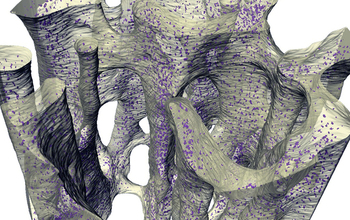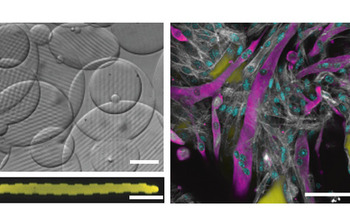All Images
NSF BRITE Fellows to explore diverse, bold engineering research ideas

NSF BRITE Fellow Christopher Hernandez of Cornell University will investigate fundamental scientific approaches needed to insert biological cells such as bacteria into structural engineering materials, such as plastics, metals, and ceramics, in order to engineer “living materials.” Living materials could have the ability to grow, heal, or exhibit other biological traits. In the future, vehicles, buildings, and commercial products that incorporate living materials could have vastly improved performance and lower financial and environmental costs.
Above, a conceptualization inspired by bone shows living materials populated by cells.Credit: Christopher J. Hernandez, Cornell University
Download the high-resolution JPG version of the image. (3.7 MB)
Use your mouse to right-click (Mac users may need to Ctrl-click) the link above and choose the option that will save the file or target to your computer.

NSF BRITE Fellow Amy Rowat of the University of California, Los Angeles, will investigate mechanical aspects of tissue engineering to develop efficient, sustainable engineering methods to grow animal protein for foods. She will study how cells sense and respond to mechanical stimuli, regulate their mechanical properties, and interact mechanically with tissue engineering scaffolds, which may influence the sensory and nutritional properties of cultured meat.
To make cultured meat a feasible protein alternative, the Rowat Lab is generating edible particles to increase the efficiency of muscle growth in vitro. Left: Edible gel particles with aligned topology are scaffolds for growing muscle cells. Scale, 200 µm. Bottom image shows a cross-section of a gel particle. Scale, 50 µm. Right: particles (shown in yellow) support the growth and differentiation of precursor muscle cells. Mouse C2C12 cells form myotubes (labeled by immunostaining the protein Myh4, purple), F-actin (white), and DNA (blue). Scale, 100 µm.Credit: Sam Norris, University of California, Los Angeles
Download the high-resolution PNG version of the image. (299.9 KB)
Use your mouse to right-click (Mac users may need to Ctrl-click) the link above and choose the option that will save the file or target to your computer.

NSF BRITE Fellow Shaochen Chen of the University of California, San Diego, will create a nanoscale biomanufacturing platform powered by artificial intelligence that can serve as a functional, three-dimensional model of human tissues, organs and systems. This “human-on-a-chip” could transform regenerative medicine and tools for disease modeling, drug screening, environmental studies, space exploration, and other applications.
Credit: Shaochen Chen and Yazhi Sun, University of California, San Diego
Download the high-resolution JPG version of the image. (588.1 KB)
Use your mouse to right-click (Mac users may need to Ctrl-click) the link above and choose the option that will save the file or target to your computer.
